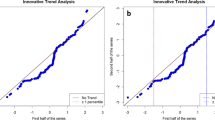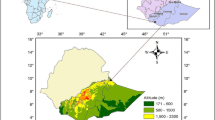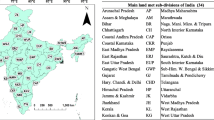Abstract
The study aims to investigate the trend of annual variations of dusty day frequency (DDF) in relation to the climatic parameters variations in the eastern part of Iran. In this regard, the data of DDF, temperature, rainfall, and wind speed for 15 meteorological stations during 1951 to 2016 was analyzed. First, the trend of mentioned parameters was detected by using the two nonparametric statistics of Mann-Kendall and Sen’s estimator slope. The results showed that there are significant spatial and temporal differences in DDF in eastern Iran, and in general, it is significantly higher in southeastern and southern areas with an annual average of 160 days than the northern areas. The highest DDF occurs in the months of July and June. The output of Mann-Kendall test showed a significant increasing trend in Zahedan, Iranshahr, Tabas, Garmsar, and Chabahar stations, while most of the stations located in the northern side had decreasing trend. The maximum upward rate of DDF in Iranshahr, Tabas and Zahedan stations was calculated as 1.35, 0.96, and 0.78 days per decade, respectively. The correlation coefficients showed that there is a positive (negative) correlation between DDF and wind speed and temperature (rainfall), and the wind speed fluctuation was the most effective climatic parameter in DDF variations. The study of dust storm wind roses showed that although dust storm occurs under various winds, since most winds blew from northwest to northeast (320 to 040 degrees clockwise), the effective role of 120-day wind of Sistan in dust storm activity was documented.






Similar content being viewed by others
References
Ahmadi Z, Doostan R, Mofidi A (2015) Synoptic analysis of dust storms in southern Khorasan Province. Manage Syst 8:41–62 [Pressed in Iran]
Aili A, Oanh NTK, Abuduwaili J (2016) Variation trends of dust storms in relation to meteorological conditions and anthropogenic impacts in the northeast edge of the Taklimakan Desert China. Air Pollut 5:127–143
Akhlaq M, Sheltami TR, Mouftah HT (2012) A review of techniques and technologies for sand and dust storm detection. Rev Environ Sci Biotechnol 11(3):305–322
Alijani B, Raispour K (2011) Statistical and synoptic analysis of dust storms in Southeast Iran: case study of Sistan Region. J Arid Rgn Geogr Stud 2:132–107 [Pressed in Iran]
Amade N, Painho M, Oliveira T (2018) Geographic information technology usage in developing countries–a case study in Mozambique. Geo-spatial Info Sci 21(4):331–345
Amgalan G, Liu GR, Lin TH, Kuo TH (2017) Correlation between dust events in Mongolia and surface wind and precipitation. Terr Atmos Ocean Sci 28:23–32
Azizi G, Shamsipour AA, Miri M, Safarrad T (2012) Statistical and synoptic analysis of dust storms in southwestern Iran. J Environ Stud 38:134–123 [Pressed in Iran]
Cannarozzo M, Noto LV, Viola F (2006) Spatial distribution of rainfall trends in Sicily. Phys Chem Earth 31:1201–1211
Cunderlik JM, Ouarda TBMJ (2009) Trends in the timing and magnitude of floods in Canada. J Hydrol 375(3/4):471–480. https://doi.org/10.1016/j.jhydrol.2009.06.050
Du M, Seiichiro Y, Shen Z, Shen Y, Wang W, Maki T (2002) Wind erosion processes during dust storm in Dunhuang, China. In the Editorial Committee (Ed.d), Proceedings 12th International Soil Conservation Organization Conference – Dynamic Monitoring, Forecasting and Evaluation of Soil Erosion Watershed Management and Development Desertification Control. Tsinghua University, China, 624–629
Fan F, Liu R (2018) Exploration of spatial and temporal characteristics of PM2. 5 concentration in Guangzhou, China using wavelet analysis and modified land use regression model [J]. Geo-spatial Info Sci 21(4):311–321
Farajzadeh Asl M, Alizadeh K (2011) Spatial analysis of dust storms in Iran. J Spatial Plan 15:65–84 [Pressed in Iran]
Fengjin X, Zhou C, Liao Y (2008) Dust storms evolution in Taklimakan Desert and its correlation with climatic parameters. J Geogr Sci 18:514–425
Ganor E, Osetinksy I, Stupp A, Alpert P (2010) Increasing trend of African dust over 49 years in the eastern Mediterranean. J Geophys Res Atmos 115:1–7. D07201. https://doi.org/10.1029/2009JD012500
Gautam R, Hsu NC, Lau KM (2010) Pre-monsoon aerosol characterization and radiative effects over the Indo-Gangetic Plains: implications for regional climate warming. J Geophys Res 115:1–15. D17208. https://doi.org/10.1029/2010JD013819
Goudie AS (2008) Dust storms: recent developments. J Environ Manag 90:89–94. https://doi.org/10.1016/j.jenvman.2008.07.007
Goudie AS (2014) Review Desert dust and human health disorders. Environ Int 63(3):101–113
Grineski SE, Staniswalis JG, Bulathsinhala P, Peng Y, Gill TE (2011) Hospital admissions for asthma and acute bronchitis in El Paso, Texas: do age, sex, and insurance status modify the effects of dust and low wind events? Environ Res 111(8):1148–1155. https://doi.org/10.1016/j.envres.2011.06.007
Guhathakurta P, Preetha M, Mazumdar AB, Sreejith OP (2010) Changes in extreme rainfall events and flood risk in India during the last century. Nat Clim Centre 3:1–22
Hahnenberger M, Nicoll K (2014) Geomorphic and land cover identification of dust sources in the eastern Great Basin of Utah U.S.A. Geomorphology 204(2):657–672
Hamzeh Hossein N, Fattahi I, Zoldehdi M, Ghaffarian P, Ranjbar A (2016) Synoptic and dynamic analysis of dust storms and its simulation in southwest of Iran in the summer of 2005. Spatial Anal Environ Hazards 1:102–191 [Pressed in Iran]
Hansell RA, Tsay SC, Ji Q, Hsu CN, Jeong MG, Wang SH (2010) An assessment of the surface long wave direct radioactive effect of airborne Saharan dust during the NAMMA field campaign. J Atmos Sci 67(4):1048–1065. https://doi.org/10.1175/2009JAS3257.1
Hirsch RM, Slack JR, Smith RA (1982) Techniques of trend analysis for monthly water quality data. Water Resour Res 18:107–121. https://doi.org/10.1029/WR018i001p00107
Johnston F, Hanigan I, Henderson S, Morgan G, Bowman D (2011) Extreme air pollution events from brushfires and dust storms and their association with mortality in Sydney Australia 1994–2007. Environ Res 111(12):811–816. https://doi.org/10.1016/j.envres.2011.05.007
Kang L, Huang J, Chen S, Wang X (2016) Long term trends of dust events over Tibetan plateau during 1961–2010. Atmos Environ 125:188–198
Kendall MG (1975) Rank auto-correlation methods. Charles Griffin, London
Kurosaki Y, Mikami M (2002) Seasonal and regional characteristics of dust event in the Taklimakan Desert. J Arid Land Stud 11:245–252
Lawrence CR, Neff JC (2009) The contemporary physical and chemical flux of aeolian dust: a synthesis of direct measurements of dust deposition. Chem Geol 267:46–63
Léon JF, Legrand M (2003) Mineral dust sources in the surroundings of the North Indian Ocean. Geophys Res Lett 30(6):1309. https://doi.org/10.1029/2002GL016690
Lim J-Y, Chun Y (2006) The characteristics of Asian dust events in Northeast Asia during the springtime from 1993 to 2004. J Glob Planet Chang 52:231–247
Mahowald NM, Bryant RG, Del Corral J, Steinberger L (2003) Ephemeral lakes and desert dust sources. Geophys Res Lett 30(2):1074–1083
Mann HB (1945) Non-parametric tests against trend. Economet 13:245–259. https://doi.org/10.2307/1907187
Masoudian SA (2011) Climatology of Iran, published by Sharia tous. 1-191 [Pressed in Iran]
Mavromatis T, Stathis D (2011) Response of the water balance in Greece to temperature and precipitation trends. Theor Appl Climatol 104:13–24. https://doi.org/10.1007/s00704-010-0320-9
Mei D, Xiushan L, Lin S, Ping W (2008) A dust storm process dynamic monitoring with multi-temporal MODIS data, Congress 21st, International Society for Photogrammetry and Remote Sensing, Beijinig China: 965–970
Mohammadi GhH (2015) Analysis of atmospheric mechanisms in dust transport over west of Iran. Ph.D. Thesis, climatology department, University of Tabriz, Iran. 127 Pages [Pressed in Iran]
Onoz B, Bayazit M (2003) The power of statistical tests for trend detection. Turk J Eng Env Sci 27:247–251
Orlovsky L, Orlovsky N, Durdyev A (2005) Dust storms in Turkmenistan. J Arid Environ 60(1):83–97. https://doi.org/10.1016/j.jaridenv.2004.02.008
Partal T, Kahya E (2006) Trend analysis in Turkish precipitation data. Hydrol Process 20(9):2011–2026. https://doi.org/10.1002/hyp.5993
Rashki A, Kaskaoutis DG, Goudie AS, Kahn RA (2013) Dryness of ephemeral lakes and consequences for dust activity: the case of the Hamoun drainage basin, southeastern Iran. Sci Total Environ 463-464:552–564 doi.org/10.1016/j.scitotenv.2013.06.045
Rashki A, Kaskaoutis DG, Sepehr A (2018) Statistical evaluation of the dust events at selected stations in Southwest Asia: from the Caspian Sea to the Arabian Sea. Catena 165(1):590–603. https://doi.org/10.1016/j.catena.2018.03.011
Rezazadeh M, Irannejad P, & Shao Y (2013) Climatology of the Middle East dust events. Aeolian Res 10:103–109
Saremi Naeini M (2016) Estimation of the frequency of speed and direction of the erosive winds and dust storms in the Yazd Province, by using windrose, stormrose and sandrose. Des Manag 4(8):96–106 [Pressed in Iran]
Sari Sarraf B, Rasouli AA, Mohammadi GHH, Hoseini Sadr A (2016) Long-term trends of seasonal dusty day characteristics—West Iran. Arab J Geosci 9(563):1–10
Shao Y, Wyrwoll KH, Chappell A, Huang J, Lin Z, McTainsh GH, Mikam M, Tanaka TY, Wang X, Yoon S (2011) Dust cycle: an emerging core theme in Earth system science. Aeolian Res 2(4):181–204. https://doi.org/10.1016/j.aeolia.2011.02.001
Topaloglu F (2006) Regional trend detection of Turkish river flows. Hydrol Res 37(2):165–182. https://doi.org/10.2166/nh.2006.006
Valenzuela A, Olmo FJ, Lyamani H, Anton M, Quirantes A, Alados-Arboledas L (2012) Aerosol radiative forcing during African desert dust events (2005–2010) over south-EasternSpain. Atmos Chem Phys 12(3):593–622. https://doi.org/10.5194/acp-12-10331-2012
Waldhauserova PD, Arnalds O, Olafsson H (2013) Long-term frequency and characteristics of dust storm events in Northeast Iceland (1949–2011). Atmos Environ 77:117–127. https://doi.org/10.1016/j.atmosenv.2013.04.075
Wang S, Wang J, Zhou Z, Shang K (2005) Regional characteristics of three kinds of dust storm events in China. Atmos Environ 39(3):509–520. https://doi.org/10.1016/j.atmosenv.2004.09.033
Wang R, Liu B, Li H, Zou X, Wang J, Liu W, Cheng H, Kang L, Zhang C (2017) Variation of strong dust storm events in northern China during 1978–2007. Atmos Res 183:166–172. https://doi.org/10.1016/j.atmosres.2016.09.002
Xu X, Levy JK, Zhaohui L, Hong C (2006) An investigation of sand–dust storm events and land surface characteristics in China using NOAA NDVI data. J Glob Planet Chang 52(1–4):182–196. https://doi.org/10.1016/j.gloplacha.2006.02.009
Yue S, Wang C (2004) The Mann-Kendall test modified by effective sample size to detect trend in serially correlated hydrological series. Water Res Manag 18(3):201–218. https://doi.org/10.1023/B:WARM.0000043140.61082.60
Yue S, Pilon P, Cavadias G (2002) Power of the Mann-Kendall and Spearman’s rho tests for detecting monotonic trends in hydrological series. J Hydrol 259(1-4):254–271. https://doi.org/10.1016/S0022-1694(01)00594-7
Zhang X, Wang L, Wang W, Cao D, Ye D (2015) Long-term trend and spatiotemporal variations of haze over China by satellite observations from 1979 to 2013. Atoms Environ 119:362–373. https://doi.org/10.1016/j.atmosenv.2015.08.053
Zhao CH, Dabu X, Li Y (2004) Relationship between climatic factors and dust storm frequency in Inner Mongolia of China. Geophys Res Lett 31:1–3. https://doi.org/10.1029/2003GL018351
Author information
Authors and Affiliations
Corresponding author
Additional information
Responsible Editor: Zhihua Zhang
Rights and permissions
About this article
Cite this article
Yarmoradi, Z., Nasiri, B., Mohammadi, G.H. et al. Long-term characteristics of the observed dusty days and its relationship with climatic parameters in East Iran. Arab J Geosci 13, 242 (2020). https://doi.org/10.1007/s12517-020-5198-y
Received:
Accepted:
Published:
DOI: https://doi.org/10.1007/s12517-020-5198-y




